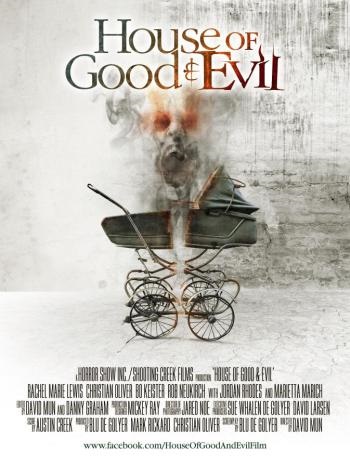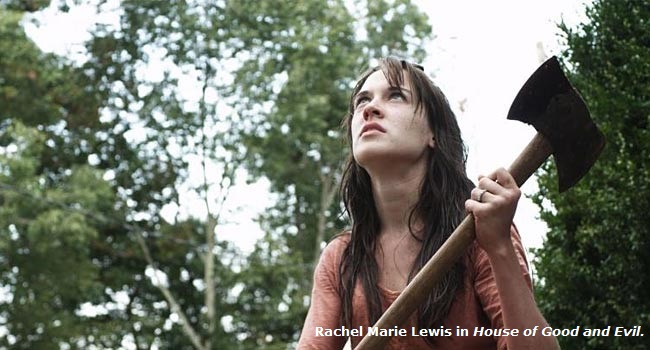HOUSE OF GOOD AND EVIL: GREAT ACTING ELEVATES FAMILIAR SPOOK TALE
by Thomas M. Sipos, managing editor [September 21, 2013]
 [HollywoodInvestigator.com] M. Night Shyamalan's 1999 The Sixth Sense reinvigorated supernatural horror, its influence still evident today. Shyamalan's formula focuses on people struggling with ordinary human problems -- the death of loved ones, illnesses, couples drifting apart -- whereupon the supernatural intrudes. (Or aliens, in the case of Signs). The story invariably leads to a (hopefully) surprise twist ending. [HollywoodInvestigator.com] M. Night Shyamalan's 1999 The Sixth Sense reinvigorated supernatural horror, its influence still evident today. Shyamalan's formula focuses on people struggling with ordinary human problems -- the death of loved ones, illnesses, couples drifting apart -- whereupon the supernatural intrudes. (Or aliens, in the case of Signs). The story invariably leads to a (hopefully) surprise twist ending.
Director David Mun's House of Good and Evil follows Shyamalan's template. We open with a young couple arguing. The man apparently hits his pregnant wife, as indicated by their silhouettes in the window. We cut to them in a car, trying to rush to the hospital but stuck in traffic. She miscarries in the car, presumably because he hit her.
We fastforward to them arriving at an isolated country house. Seems they're trying to make a fresh start of their marriage.
There's much going on here. Apart from being a wife-beater, the husband, Chris, is also an alcoholic. Wife Maggie has mental issues even without the beatings and miscarriage (after which, she can never again conceive a child). She might even be schizophrenic.
Being a fireman for the forest service, Chris leaves Maggie alone for days at a time. They have only one neighbor, an elderly mystery couple who are never seen. Maggie can hear their arguments next door, and a phone ringing, but no response to her knocks or shouting.
Maggie has strange visions. Are they ghosts or is she insane?
Rather than Shyamalan, writer/producer Blu de Golyer cites The Shining as a primary influence. "Both [director] Dave Mun and I are fans of Kubrick. Dave has been wanting to direct this film for nearly a decade. But investors didn't want to risk on a first-time director. He kept a shot list in his back pocket for years, even though chances were slim he'd ever get to direct this film.
"We've had some great names attached to the director's chair, including Clint Howard. Clint had his brother [Ron Howard] give notes on the script, which we implemented, making the script better.
"Well, we were never able to raise the large budget, so when an opportunity came to do this film using our own money, we had to rethink things. It was time to give Dave a chance. We shot the film for $60,000 from my wife and my savings. After post-production, marketing, distribution deliverables, the budget is hovering around $150,000.

"The entire process, from day one of principal photography, to the day we signed the contracts with our distributors, took nine months." Many filmmakers relate horror stories about being ripped-off by distributors, but so far, things are good for de Golyer. "We've teamed up with two great distribution companies, Phase 4 Films and Acort International. We are starting to see recoupement."
Although the film's dialogue is decent, its story is familiar -- its "surprise" twist ending annoyingly so. The ending is unexpected, but also arbitrary. Worse, it's an ending that has become commonplace, with minor variations, in supernatural horror films over the past 10-15 years, and might elicit groans from viewers.

The film's greatest asset is its lead actress, Rachel Marie Lewis (Transatlantic Coffee), as Maggie. Many actors have played crazy, but Lewis's Maggie displays a diverse and nuanced range of crazy. Her crazy runs from suspicion to paranoia, trepidation to terror, resentment to rage. Of course, she can also appear normal. She responds as provoked by the situation, and all her responses are well-motivated.

While Lewis's is the standout performance, all the actors are quite good. No surprise, since it's a surprisingly seasoned cast for a low-budget, indie horror film. Christian Oliver (Saved by the Bell, The Good German) is husband Chris. The mystery couple (who eventually emerge) are played by Marietta Marich (Simple Men, The Texas Chainsaw Massacre) and Jordan Rhodes (Matlock, The Night Stalker).
De Golyer obtained his professional cast through Dream Big Casting. "Tippi Hedren was attached for five years. She bailed out three days before shooting due to a health scare. She was replaced with the very talented Marietta Marich. We had veteran character actor Terrence Evans (The Texas Chainsaw Massacre) attached to play Mr. Anderson. He also had a health issue only days before shooting. Basically, half our cast was replaced at the last moment. Things got a little stressful."

House of Good and Evil was shot with a RED camera and edited on Final Cut Pro. "The opening scene was shot in Baltimore. [The rest of the film] was in Floyd, Virginia, the easiest and most film-friendly town we've ever come across. We will be shooting our next few projects there. We saved a lot of money with the help of that community. "
De Golyer describes himself as "a screenwriter and ghostwriter, having written 42 screenplays." He says House of Good and Evil is set for North American release on October 1. It's also doing the film festival circuit and has won several awards.
"We are developing a television series, The Lycanthropist, a new spin on the werewolf genre. The script made the quarter-finals at Slamdance. I'm also working on a new horror film, Devious."

|
